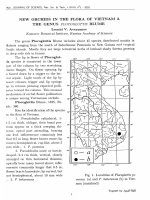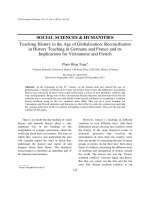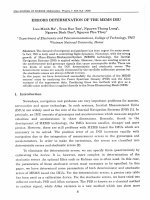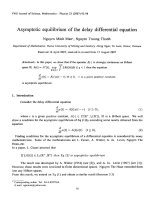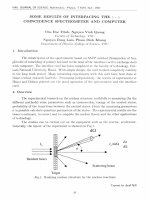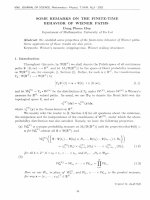DSpace at VNU: Chemical constituents of the essential oil from the bark of Cinnamomum illicioides A. Chev. from Vietnam
Bạn đang xem bản rút gọn của tài liệu. Xem và tải ngay bản đầy đủ của tài liệu tại đây (219.7 KB, 3 trang )
J Nat Med (2006) 60:248–250
DOI 10.1007/s11418-006-0039-1
NOTE
Phan Minh Giang Æ Wilfried A. Ko¨nig Æ Phan Tong Son
Chemical constituents of the essential oil from the bark
of Cinnamomum illicioides A. Chev. from Vietnam
Received: 6 October 2005 / Accepted: 16 January 2006 / Published online: 24 May 2006
Ó The Japanese Society of Pharmacognosy and Springer-Verlag 2006
Abstract The chemical constituents of the hydrodistilled essential oil from the bark of Cinnamomum illicioides A. Chev., Lauraceae, from Vietnam, have been
studied by GC and GC–MS. Seventeen monoterpenoids, eugenol, and thirty-six sesquiterpenoids,
accounting for 25, 41.2, and 27.9% of the oil, respectively, were identified. Terpinen-4-ol (10.4%), eugenol
(41.2%), and d-cadinene (5.6%) are the major components of the oil.
Keywords Cinnamomum illicioides Æ Lauraceae Æ
Eugenol Æ Terpinen-4-ol Æ d-Cadinene Æ GC Æ GC–MS
Introduction
The tree Cinnamomum illicioides A. Chev. (Lauraceae),
commonly known in Vietnam as Gu huong, is up to
30 m tall and 1–1.5 m in diameter. The plant grows in
forested valleys or in dense forest approximately 800 m
above sea level in Hainan, Guangxi (China), and
Northern Vietnam. Cinnamomum camphora, C. balansae, C. burmannii, C. aromaticum, C. cassia, C.
caryophyllus, C. iners, C. loureirii, C. obtusifolium,
C. parthenoxylon, C. simmondii, C. tetragonum, and C.
zeylanicum, which are known to produce essential oils,
W.A. Ko¨nig passed away on 19 November 2004.
P.M. Giang Æ P.T. Son (&)
Faculty of Chemistry, College of Natural Science,
Vietnam National University, 19 Le Thanh Tong Street,
Hanoi, Vietnam
E-mail:
Tel.: +84-4-8351439
Fax: +84-4-8262932
W.A. Ko¨nig
Institut fu¨r Organische Chemie,
Universita¨t Hamburg, 20146 Hamburg, Germany
are used in Vietnamese traditional medicine [1]. The
odor of C. illicioides is reported to be similar to that of
C. camphora L. Nees. et Eberm. (syn. Laurus camphora
L.); the tree is, therefore, a very interesting target for
research. Although investigation of the chemical constituents of other Cinnamomum species, for example C.
cassia, C. zeylanicum, or C. osmophloeum, and correlation of these with their antibacterial and antifungal
activity has been extensively undertaken [2–4], there is
no report of the chemical constituents of C. illicioides
essential oil. Our study revealed that hydrodistillation
of the dried bark of C. illicioides furnished a large
amount of essential oil (1.36% yield based on the dry
material). Chemical study of this essential oil has revealed the presence of constituents which, by correlation with those of previously investigated Cinnamomum
oils, will help us to examine the economic value of the
oil as a natural flavoring and/or antibacterial and
antifungal agent. This paper reports the analysis of the
chemical constituents of the essential oil from the dried
bark of C. illicioides.
Results and discussion
Fifty-four components of the essential oil from the
dried bark of C. illicioides, representing 94.1% of the
oil, were identified in this study. Seventeen monoterpenoids, eugenol, and thirty-six sesquiterpenoids
accounting for 25, 41.2, and 27.9% of the oil,
respectively, are listed in Table 1. The oil is rich in
eugenol (41.2%) and terpinen-4-ol (10.4%), which can
be used as chemical markers of the oil. d-Cadinene
(5.6%), a-copaene (4.1%), (E)-b-caryophyllene (3.0%),
and a-cadinol (1.6%) are the most abundant sesquiterpenoid components. A gas chromatogram obtained
from the essential oil is shown in Fig. 1. Previous
studies classified two samples of C. cassia and C.
zeylanicum bark oils from Taiwan into cinnamaldehyde–coumarin [2] and cinnamaldehyde–eugenol types
[3], respectively, on the basis of the main constituents
249
Table 1 Constituents of the essential oil from the dried bark of
Cinnamomum illicioides
a
No.
Compound
Content (%)
1
2
3
4
5
6
7
8
9
10
11
12
13
14
15
16
17
18
19
20
21
22
23
24
25
26
27
28
29
30
31
32
33
34
35
36
37
38
39
40
41
42
43
44
45
46
47
48
49
50
51
52
53
54
a-Thujene
a-Pinene
Camphene
b-Pinene
Myrcene
a-Terpinene
p-Cymene
1,8-Cineol
c-Terpinene
Terpinolene
cis-p-Menthen-2-en-1-ol
Pinocarvone
Borneol
Terpinen-4-ol
a-Terpineol
Bornyl acetate
Carvacrol
Eugenol
a-Cubebene
a-Copaene
b-Elemene
cis-a-Bergamotene
(E)-b-Caryophyllene
trans-a-Bergamotene
Guaia-6,9-diene
Aromadendrene
4aH,10aH-Guaia-1(5),6-diene
a-Humulene
allo-Aromadendrene
7aH,10bH-Cadina-1(6),4-diene
5-epi-Aristolochene
b-Neoclovene
c-Humulene
Eremophyla-1(10),7-diene
a-Muurolene
(E,E)-a-Farnesene
c-Cadinene
Calamenene
d-Cadinene
Zonarene
Cadina-1,4-diene
a-Calacorene
Elemol
Spathulenol
Globulol
a-Guaiol
1-epi-Cubenol
T-Muurolol
Amorph-4-en-7-ol
a-Cadinol
Eudesm-4(15)-en-7-ol
7-epi-a-Eudesmol
Bulnesol
Cadalene
0.1
1.9
0.5
0.9
0.3
0.4
1.1
2.6
0.5
0.2
tr.c
0.1
2.7
10.4
3.3
tr.
tr.
41.2
1.4
4.1
0.5
tr.
3.0
tr.
0.2
tr.
0.2
0.8
0.2
0.8
0.3
0.1
0.2
0.3
0.7
0.1
0.4
0.8
5.6
tr.
0.6
0.2
0.2
0.3
0.2
1.1
1.2
1.0
1.0
1.6
tr.
tr.
0.7
0.1
Experimental
b
a
Numbering refers to Fig. 1
Relative percentages of components were calculated using the GC
CPSil-5-CB column
c
Trace constituent ( £ 0.05%)
b
of the oils. The bark oil of C. illicioides from Vietnam
could therefore be classified as the eugenol–terpinen-4ol type.
Plant material and oil preparation
The dried bark of C. illicioides A. Chev. (Lauraceae) was
collected in Province Thai Nguyen, Vietnam. The plant
was identified by Dr Nguyen Hoanh Coi, a botanical
taxonomist of the Military Institute of Pharmaceutical
Research and Control, Hanoi, Vietnam, in September
2001, and a voucher specimen (HCTN CI 9-01) is
deposited in the Laboratory of Chemistry of Natural
Products, Faculty of Chemistry, Vietnam National
University, Hanoi, Vietnam. The bark was ground to
powder and hydrodistillation of the material for 8 h
produced an oil in 1.36% yield.
Gas chromatography (GC)
An Orion Micromat 412 instrument equipped with two
fused-silica capillary columns (25 m·0.25 mm i.d., film
thickness 0.15 lm), coated with CPSil-5-CB and CPSil19-CB, split injection, and flame ionization detection,
was used. Injector and detector temperatures were at 200
and 250°C. The oven temperature was programmed
from 50 to 230°C at 3° minÀ1. The carrier gas was H2 at
1.2 mL minÀ1.
Gas chromatography–mass spectrometry (GC–MS)
A Hewlett–Packard HP 5890 gas chromatograph coupled to a VG Analytical 70-250S mass spectrometer was
used. The GC was fitted with a fused-silica capillary
column coated with CPSil-5-CB (25 m·0.25 mm i.d.,
film thickness 0.15 lm). The GC operating conditions
were identical with those described above except that
helium was used as carrier gas. The MS operating conditions were: ionization potential 70 eV and ion source
temperature 230°C.
Identification of the components
The oil was analyzed by dual GC on a non-polar CPSil5-CB capillary column and on a more polar CPSil-19CB capillary column of identical dimensions. GC–MS
was performed with a CPSil-5-CB column. Compounds
were identified by comparison of retention indices and
mass spectra with those of authentic samples, obtained
under identical experimental conditions, and use of a
computer-supported spectral library (MassFinder 2.3)
[5, 6].
250
Fig. 1 Gas chromatogram obtained from the essential oil of Cinnamomum illicioides of Vietnam
Acknowledgment The authors are grateful to the VolkswagenStiftung (Partnerschaftsvorhaben ‘‘Untersuchung a¨therischer O¨le
Vietnams’’) for financial support of this work.
References
1. Do TL (1991) Medicinal plants and herbal remedies of Vietnam.
Science and Technique, Hanoi
2. Hu TW, Lin YT, Ho CK (1985) Natural variation of chemical
components of the leaf oil of Cinnamomum osmophloeum Kaneh.
Bulletin of Taiwan Forestry Research Industry, New Series
78:18
3. Ross MSF (1976) Analysis of cinnamon oils by high-pressure
liquid chromatography. J Chromatogr 118:273–275
4. Chang ST, Chen PF, Chang SC (2001) Antibacterial activity of
leaf essential oils and their constituents from Cinnamomum osmophloeum. J Ethnopharmacol 77:123–127
5. Joulain D, Ko¨nig WA (1998) The atlas of spectral data of sesquiterpene hydrocarbons. E.B.-Verlag, Hamburg
6. Hochmuth DH, Ko¨nig WA, Joulain D (2003) MassFinder 2.3,
Software & Data Bank, Hamburg. Available at: http://
www.massfinder.com


